The Javan rhino is a grey-colored beast with a longhorn. Its bumpy, armored appearance makes it resemble a helmet. It has a smaller head and no bumps on its skin; however, it significantly reaches the more excellent one-horned Rhino.
The Javan Rhino is native to Indonesia’s Javan region but has been observed in Myanmar, Malaysia, and Thailand. The Javan rhino is a critically endangered species, as its range has been reduced by habitat loss and poaching for their horns and medicinal purposes. They are presently at high risk of extinction, with less than 50 Javan rhinos remaining in the wild.
- Status: Critically Endangered
- Known as: Javan Rhino, Lesser One-horned Rhinoceros, Sunda Rhinoceros.
- Estimated numbers left in the wild: 60 or less.
Description
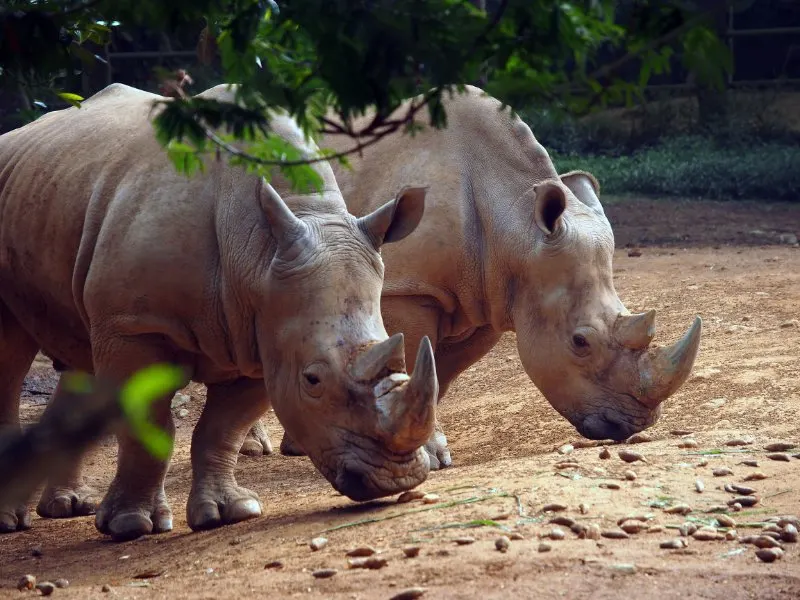
Armored with a thick, deeply folded hide, the Javan rhino has a prehistoric look that evokes the earlier periods of the Mammals’ age. This species of rhinoceros weighs 900 to 2,300 kilograms, stands 1.5 to 1.7 meters tall, and measures between 2 and 4 meters long.
The animal’s single horn is too short to be used as a weapon, at only 20 centimeters or less. Instead, it appears to be a specialized tool for hooking high-growing plants to bring them down to a level where the Rhino can eat them or push through dense vegetation.
When the Rhino is forced to fight, it slashes with its lower incisors rather than attempting to use its horn. Food harvesting is accomplished with a prehensile upper lip.
During the day’s heat, the Javan rhino lies in mud wallows to stay calm or bathes in water. When the more relaxed evening comes, these rhinoceroses begin to forage, eating leaves, shoots, twigs, and fruit. They need regular access to salt licks and will drink ocean water to get salt if necessary.
They are timid and retiring, and any human activity is enough to make them flee into the most inaccessible area available. The Javan rhino lives most frequently in tall, thick grass or beds of reeds within lowland jungles and rainforests.
Javan rhinos tend to be solitary, though they do not seem hostile to others of their species. They may sometimes casually associate in small groups at salt licks or favorite wallows. Male rhinos mark their territories with dung piles and by mauling vegetation.
Female rhinos are ready to have their first calf at four years and are likely to reproduce every five or six years after that.
See Related: African Elephant
Location
The Javan rhinoceros is found in Java and possibly in Vietnam. But, the Vietnamese population is probably extinct soon because no adult males allow breeding.
This Rhino is found in highly lush lowland rainforests, though it will live at higher altitudes if driven there by humans.
See Related: Environmental Organizations in Africa
Conservation
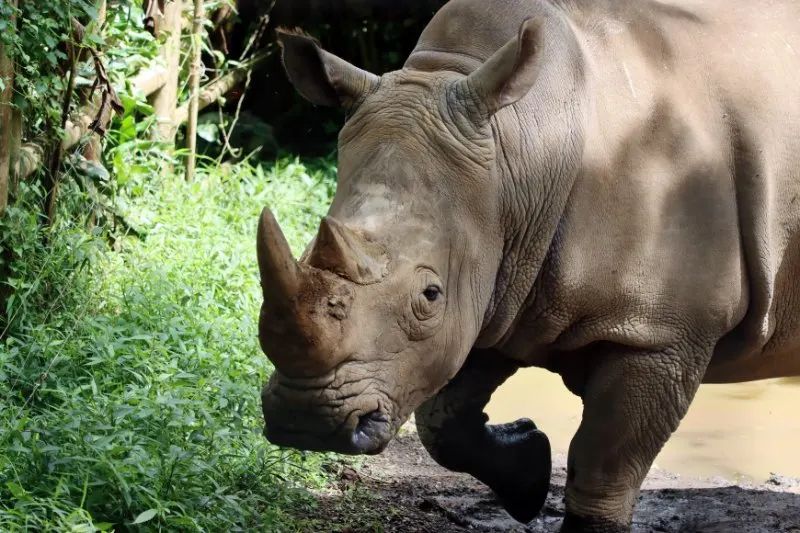
Threats
Extinction may loom for the Javan rhino, which has slowly been pushed back over the centuries by hunting and habitat destruction. Today, these problems have reached crisis proportions.
The tiny remaining population is still being hunted to supply the insatiable Chinese market with “medicinal” rhino horns. Besides, the jungle is being cut down, and habitat fragmentation is underway.
See Related: Endangered Species in Oklahoma
Conservation Efforts
Conservation of this critically endangered rhino species is spearheaded by the International Rhino Fund and the World Wildlife Foundation. Some conservation efforts include working for more sustainable farming close by and finding alternative sources of Chinese medicine that do not involve shooting rhinos.
Future projects that are now being worked on include creating more sanctuaries and devising plans to make existing covers safer and better protected for this million-year-old species of rhinoceros.
About the Javan Rhino
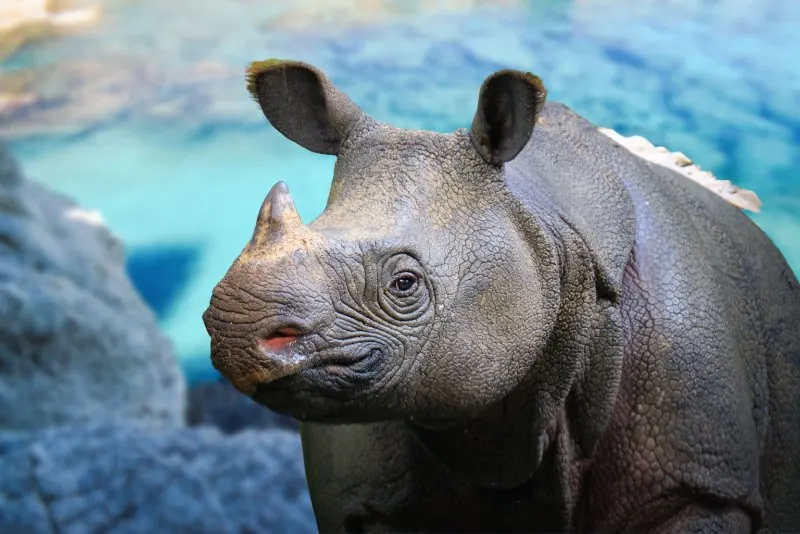
It is the smallest (closer in size to the black rhinoceros of the genus Diceros) and most recently extinct species of rhinoceros. It belongs to the same genus as the Indian rhinoceros and has similar mosaic, armor-like skin. Still, it is smaller (closer to the black rhinoceros of the genus Diceros).
Its horn is usually shorter than 9.8 inches and smaller than the other rhino species. Only adult males have horns; females lack them altogether. Javan rhinos have been recorded as living up to 45 years in captivity.
Habitat
The Sumatran rhinoceros was once found across Assam and Bengal (where their ranges may have overlapped with both the Indian and Sumatran rhinos) eastward to Burma, Thailand, Cambodia, Laos, Vietnam, and perhaps as far south as the Malay Peninsula and islands of Sumatra, Java, and possibly Borneo.
The Javan rhino prefers thick, lowland rainforests, grasslands, and reed beds with numerous waterways, massive floodplains, or wet areas with many mud wallows. Despite its preference for low-lying regions, the Vietnamese subspecies were forced to higher ground (up to 2,000 m or 6561 ft), probably because of human encroachment and poaching.
Diet & Nutrition
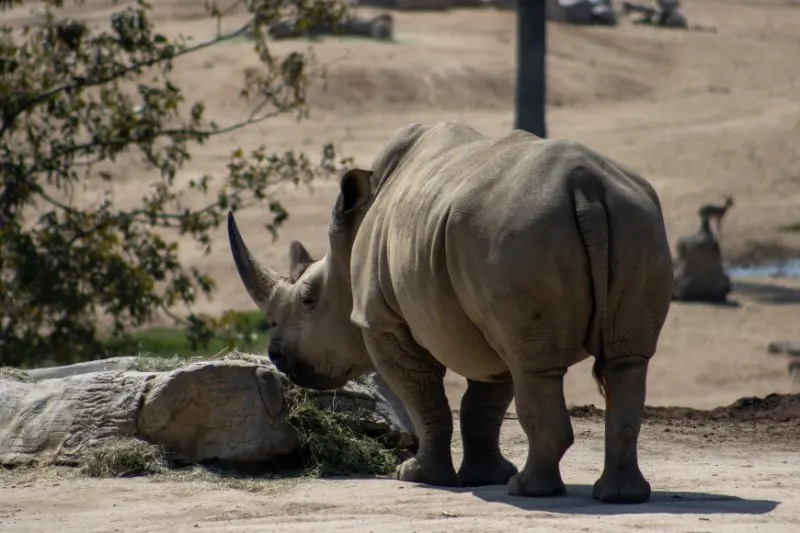
The Javan rhinoceros is primarily herbivorous, eating plants including trees’ shoots, twigs, young foliage, and fallen fruit. Most species’ preferred plants grow in shaded areas in jungle clearings, scrubland, and other vegetation types without large trees.
The Javan rhino uses its prehensile upper lip to pluck leaves from the trees and eat them. Thanks to its ability to knock down trees, it is the most versatile feeder of all the rhino species. It is presently a pure browser, but it was formerly both browsed and grazed in its ancient range. The Rhino consumes approximately 50kg of food daily.
It, too, requires salt in its diet, as does the Sumatran Rhino. The salt licks formerly available throughout its historical territory do not exist in Ujung Kulon; however, rhinos have been observed drinking seawater, which they may do for the same nutritional need.
What disease is killing the Javan rhinos?
The disease that is killing the Javan rhinos is fungal infection caused by Fusarium solani. This disease is known as rhinoconjunctivitis and has caused the death of multiple Javan rhinos in Indonesia. The fungus infects the respiratory system of the rhinos and causes respiratory distress, leading to their death.
Javan Rhino is under threat of extinction.
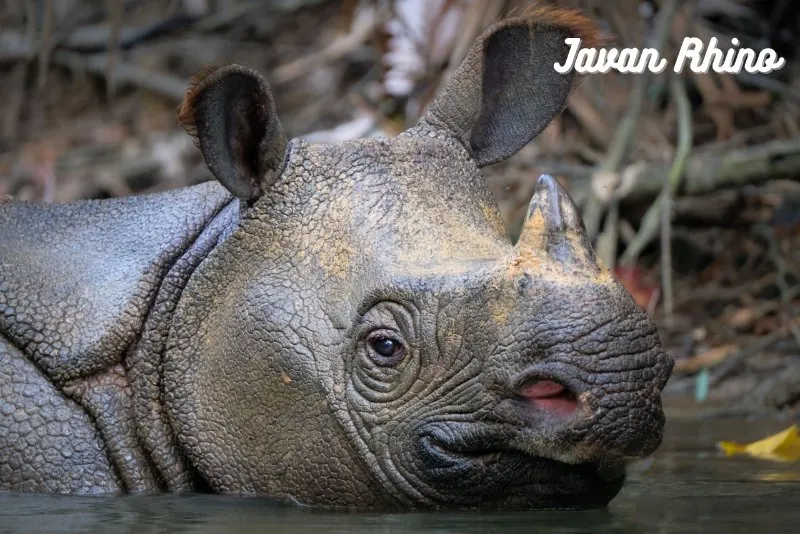
The main danger they face is poaching to feed the global rhino horn trade, as with all five existing rhino species. The Javan rhino has been listed as Critically Endangered owing to habitat loss and population fragmentation. Just under 50 individuals remain in the wild, making it one of the rarest species on the planet. They may exist in a tiny group in Java’s Ujung Kulon National Park, east of Jakarta.
The Javan rhino is the only member of its species in the Rhinoceros genus, among just five remaining species in the Rhino family. Rhinos and equids are the sole surviving members of a long-extinct group of ungulates that dates back some 50 million years.
Even though these species inhabit national parks now, they are still threatened by poaching, and small population sizes make them highly vulnerable to disease and natural disasters.
See Related: Conservation vs. Preservation
When did Javan rhinos become endangered?
Javan rhinos became endangered due to habitat loss and poaching. The International Union for Conservation of Nature (IUCN) declared them critically endangered in 1967. Today, there are only around 72 Javan rhinos left in the world.
Rhino Conservation Organizations
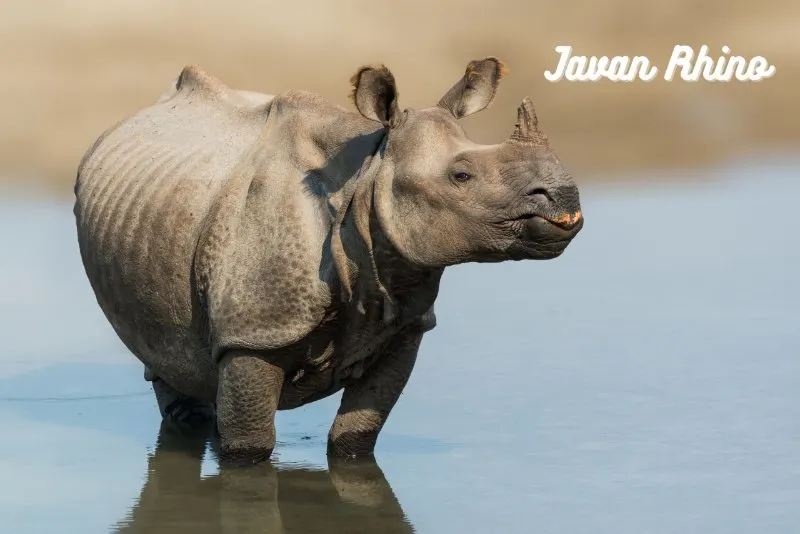
Save the Rhino
Save the Rhino works with local partners in Asia and Africa to protect the five different rhino species. They support anti-poaching activities, monitoring, environmental education, community conservation, translocations, and captive breeding.
What is causing rhinos to be endangered?
Rhinos are endangered due to a combination of factors. Still, the primary cause is poaching for their horns, which are highly valued in traditional Asian medicine and as a status symbol. Additionally, habitat loss and fragmentation, coupled with civil unrest and armed conflicts in some areas, have contributed to the decline of rhino populations. It is estimated that there are fewer than 30,000 rhinos left in the wild.
Conclusion
Javan Rhinos are native to the Javan region of Indonesia but have also been spotted in Myanmar, Malaysia, and Thailand. These species are considered endangered by the IUCN Red list due to habitat loss, poaching for their horns and medicinal purposes, and hunting for food.
They are currently at high risk of extinction, with less than 50 Javan rhinos left in the wild today. This is an endangered species and is under threat of death. Its population is declining and is already rare, so it belongs on the critically endangered list.
Javan Rhino is a type of Rhino that’s native to the Javan region of Indonesia and is endangered because it has been poached for its horn which is believed to be used for medicinal purposes. Not only that but they have also been hunted as food sources.
FAQ
What is Javan Rhino?
The Javan rhino is a grey creature with a long horn. Its bumpy, armored appearance gives it the formation of a helmet. Its head is smaller, and its skin is smooth, but it has many of the same features as the great one-horned Rhino.
The Javan rhinoceros was once the most common Asian rhinoceroses, ranging throughout Southeast Asia and into India and China. The species is on the verge of extinction, with just one known population in the wild and no individuals in captivity.
How big is the Javan Rhino habitat?
The Javan rhinoceros’ range has been contracting for at least 3,000 years. The northern Rhino’s territory extended into China, beginning around 1000 BC. Still, it moved southward at approximately 0.5 km (0.31 mi) each year as human settlements grew close by around 400 BC.
As reported by some accounts, the Javan rhino was hunted to extinction on the Malay Peninsula by 1932. The last ones on Sumatra perished during World War II. They were gone from Chittagong and the Sunderbans by the middle of the 20th century. The Vietnamese rhinoceros was thought extinct across mainland Asia by the conclusion of the Vietnam War.
As reported by local myths in Cambodia, Javan rhinos have been sighted in the Cardamom Mountains. But, surveys of the region have failed to turn up any proof of their presence. A tiny group was discovered in Vietnam’s Cat Tien region in the late 1980s.
Where do Javan Rhinos live?
Even the most optimistic scenario forecasts less than a hundred Javan rhinos today. They are one of the world’s most endangered species, with estimates suggesting only a few hundred exist. The Ujung Kulon National Park on Java’s western extremity is home to the last known population of Javan rhinoceros.
This animal once lived in many places. They could live with the Indian and Sumatran rhinoceroses, which means they would have been in Assam, Bengal, Myanmar, Thailand, Cambodia, Laos, and Vietnam. They also lived on islands like Sumatra, Java, and maybe Borneo.
The Javan rhino primarily inhabits dense, lowland rain forests, grasslands, and reed beds with abundant rivers, extensive floodplains, or wet areas with many mud wallows. Although it historically preferred low-lying areas, the subspecies in Vietnam were pushed onto much higher ground (up to 2,000 m or 6,561 ft), probably because of human encroachment and poaching.
Why are Javans Rhinos endangered?
The Sumatran rhinoceros, viewed as exceedingly rare in 2000, has been assessed as critically endangered by the IUCN Red List. Even though this species has not been seen since 2010 in Borneo, a few individuals may remain.
The most serious hazard to the Javan rhino is the tiny size of the remaining population. This leads to inbreeding and loss of genetic diversity and vitality. The two habitats where Javan rhinos live are safe, but they are too limited for the species’ long-term survival.
Poaching, habitat loss, and declining population are the Rhino’s most significant problems. Habitat destruction and loss for agriculture and construction are additional dangers to the rhino populations. Although habitat is not presently a limiting factor, neither of the two remaining habitats is big enough to allow significant expansion of the rhino population now or in the future.
Javan rhinos need to be reintroduced into areas where they have previously been hunted,d and their habitats must be revived. These elements are crucial components of the species’ conservation plan.
How many Javan rhinos are left?
The Javan Rhino is one of the rarest large mammals in the world and is critically endangered. Fewer than 80 Javan Rhinos are believed to be left in the wild. The main threats to their survival include habitat loss, poaching, and natural disasters.
Other Species Profiles
Related Resources
